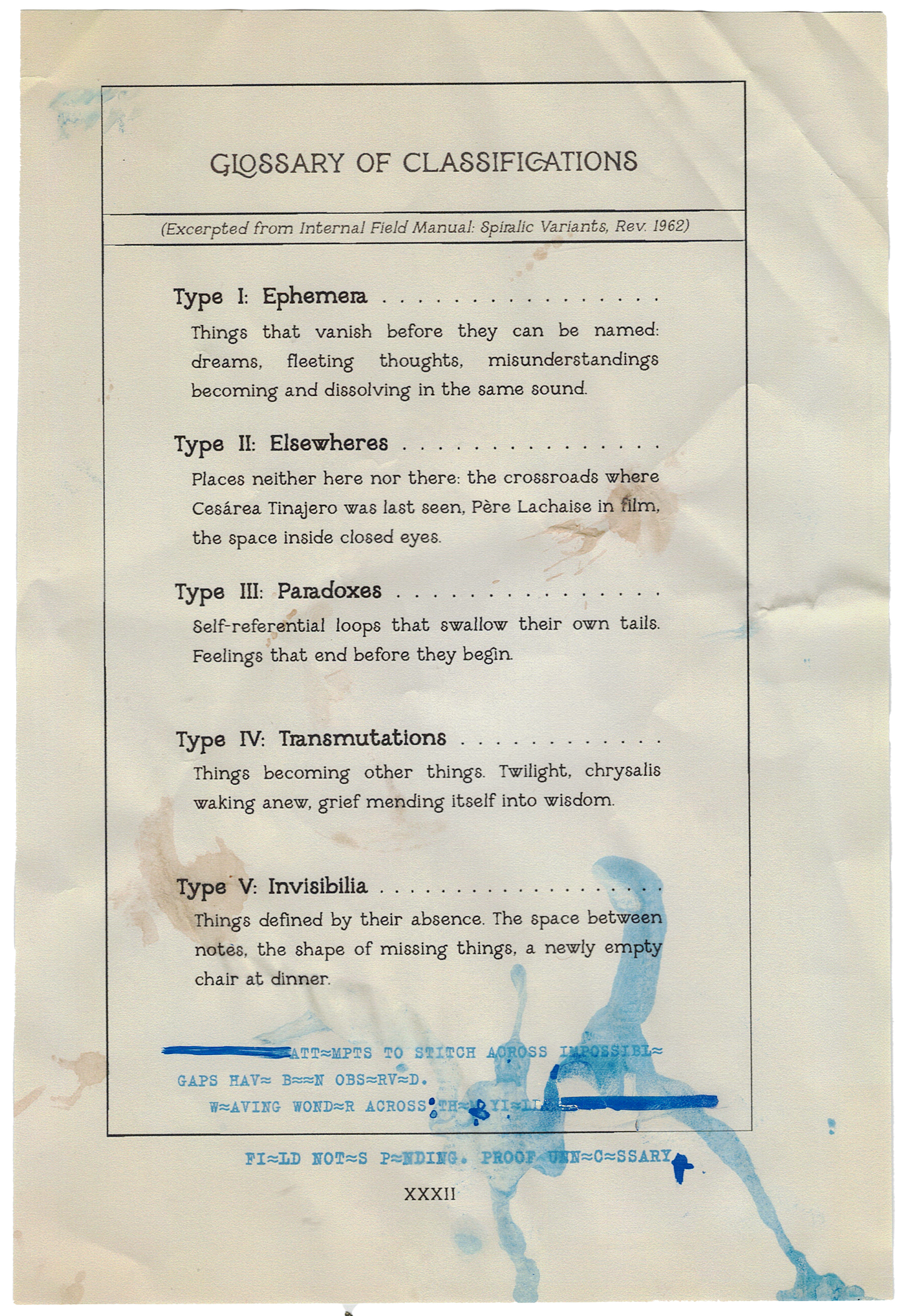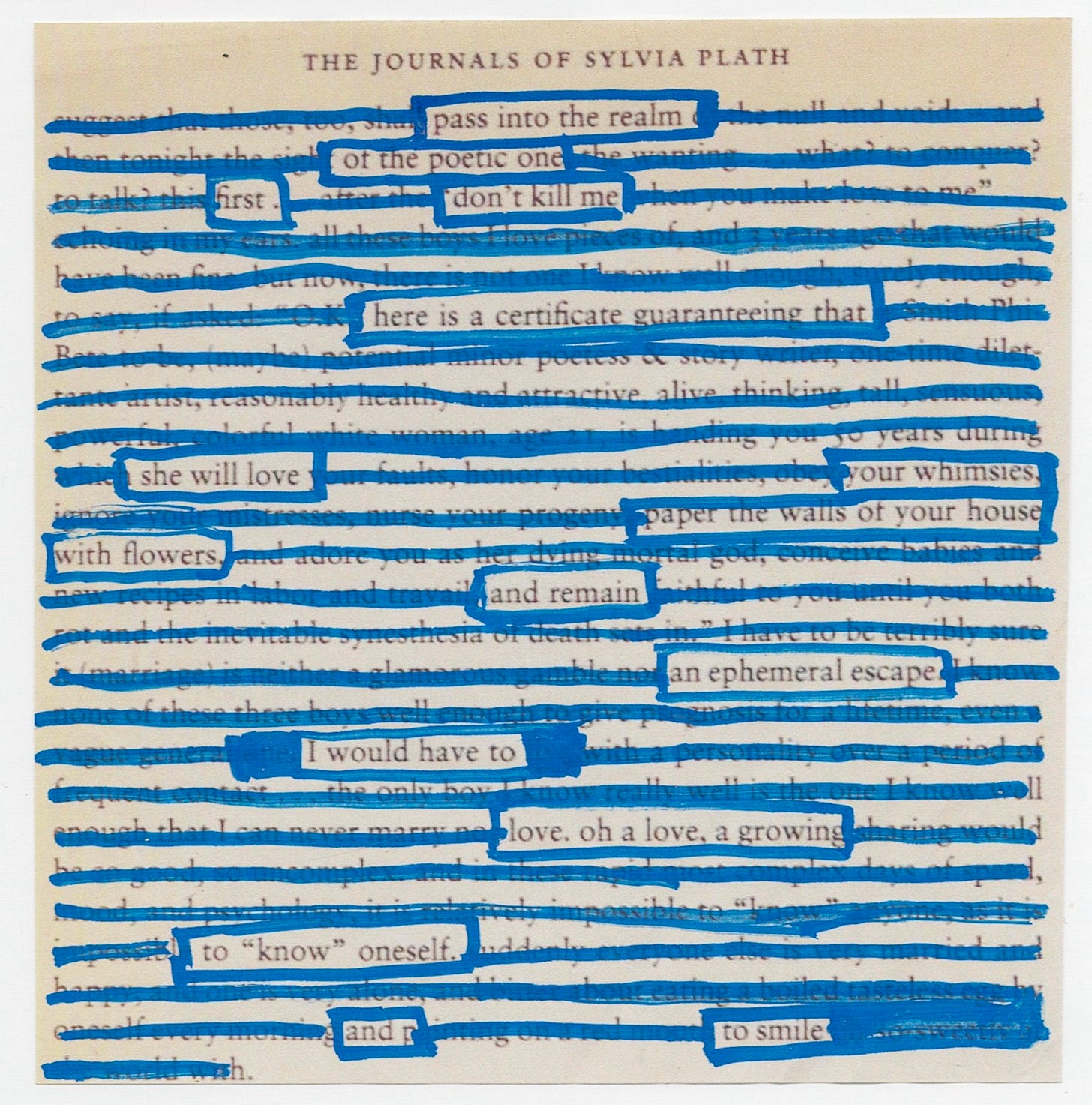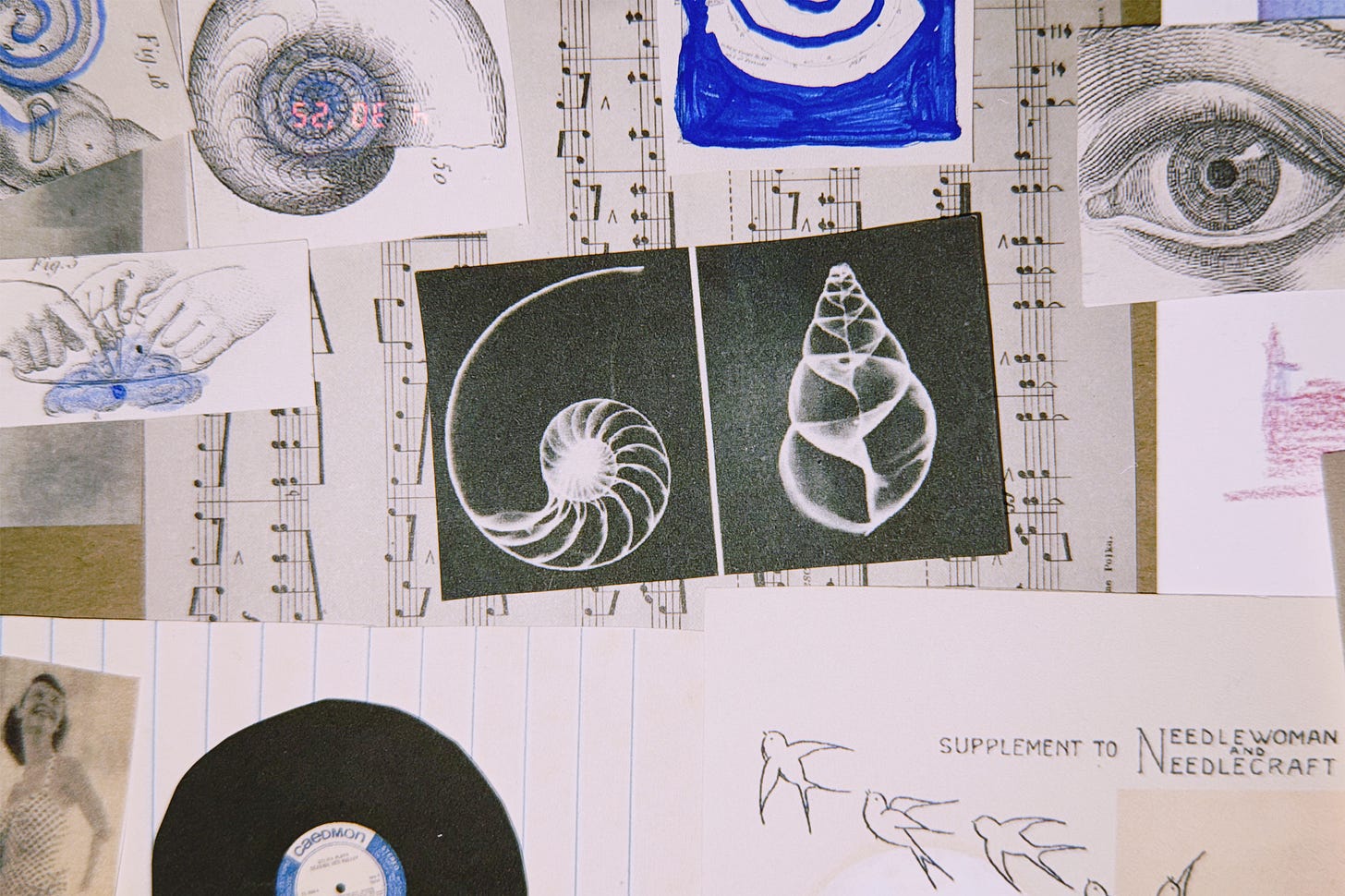REMAINS TO BE SEWN is an atlas for the elusive — evidence that the most important questions refuse to explain themselves.
Field Catalogue Entry:
Collection 001: Spirals & Coils
Specimen: Fig. 001.1 — Resonance
I found this first note during a strange and sticky week last summer — somewhere near 12th and Broadway. It fell from an empty shelf. “Catalog th≈s≈,” it said, in blue ink. So I have.
[Transcription: Attempts to stitch across impossible
gaps have been observed.
Weaving wonder across them yields [REDACTED].
Field notes pending. Proof unnecessary.]ARCHIVE ACCESS PROTOCOLS
Don’t be alarmed by the shifty punctuation. It’s not a flaw in the narrative. Nor a glitch in the matrix1. You may not remember how you arrived here.
It could be something you clicked. Or dreamt. Or remembered.
So, please make yourself at home. You're invited to follow what glimmers — links with hypermasks, windows pretending to be images, constellations disguised as punctuation. Some trails will mislead you. Some will spiral back. Trust nothing — except your own widening awe.
Note: Handle with gloved skepticism, and a mind slightly ajar.
(Some specimens react under certain conditions: 13:13 hrs on blue days, new moons on Sundays. They might misbehave or even have an impromptu outbreak of [REDACTED]. You’ve been warned.)And so, our collection begins, as all great ones should—with a themed-mixtape and a spiral-shaped Hole for the rabbit’s Curiosity to tumble into. Let there be Sound. Hit it:
Outside is warm and blue and April2. Sylvia once wrote. And today, she is right.
I'd love to say I planned that coincidence, but the most curious pieces in this archive arrive by way of synchronicity — a touch, a glance, a note — echoing down unseen corridors until they find you.
The spring fog has lifted, and my window outlines the inevitable: a portal rippling toward the mirror where I once mistook Sylvia’s sadness for my own. I am, regrettably, fifteen. Forgive this minor detour. It was inevitable, too.
Fig. 001.1 — RESONANCE
Specimen #17: Auditory threshold variant (Type I: Ephemera)
Transcription: Some listeners report waking elsewhere after exposure. Most Specimens appear to mutate based on observer's emotional weather. Further study encouraged (perhaps even necessary).
Note: All “E”s in the original have been replaced with ≈.
Reader may interpret.We are walking museums3 of the spiral form. Our ears transform invisible spiral4 waves into sound, into meaning, into memory — specialized chambers capturing what escapes other nets. Even our cells remember the spiral that will be, the one we came from and the split that sent us spinning into being.
It's been well-documented that these patterns under scrutiny reveal themselves as a web, a maze with no solution except to follow it inward. We are nature's most elegant contradiction: utterly common, and yet delightfully singular.
As for me — I've come to accept, reluctantly, the labyrinthine nature of thought itself. Memory, too, spirals. Sometimes, a sound finds you faster5 than retracing your steps (or at least, that’s been true for me.)
Like hearing Sylvia's voice and suddenly finding my window transformed into a mirror6 reflecting me back at fifteen — a girl7 reciting borrowed words with insufferable possessiveness while her truer self remained hidden, searching. I wrote to Sylvia then too, though I'll spare you that click. I wrote her letters of kinship before I knew how the whole melodrama ended. I devoured her, comma after comma, forgetting myself entirely until her voice, years later, led me back to who I had been.
This is how resonance8 travels in time. One word summons a song. A song unfurls a season. A season resurrects a forgotten friend.
Her voice opened many doors, and brought back the writer who made me fall in love with literary mysteries:9 Bolaño — whose prose rarely says anything outright, and instead lets the structure—the medium itself—do the heavy lifting.
In the final pages of The Savage Detectives, he gives up on tidy endings altogether and writes in riddles and doodles instead: a boat tracing scribbles on a page’s sea, a tiny star, a barely-there window asking us to look. Is he suggesting that language alone is mostly insufficient? Maybe. Or maybe he's just laughing from the other side of the page, asking "What's outside the window?"
I like to think that behind Cesárea’s stitched square, stands the reader: you, me, us. And that maybe, it suggests that there was never a window at all — only the world we continue searching for, framed by before, today, always. Only loose pieces, but still enough to build a map10 for our dreams to navigate.
Poets11 live between the mundane and the sacred — a precarious position that grants the most curious, the best view of both territories. A window can be a mirror, a lake, a portal — or even a [REDACTED].
Perhaps the most revealing windows are simply those resonance chambers we carry in our heads, where some days memories ripple. And we can glimpse at ourselves for a single beat exactly as we are: boundless, connected, impossible to catalogue.
Today is warm and blue and April. I think of Sylvia, again. And about how the terrible fish was only terrible when we fear our own depths. I think of Cesárea’s dotted square, and how it was never the riddle — but an invitation: to see, to question, to fly.
So I’ve opened the window — and now it’s warm and blue inside, too.
The spiral, after all, might just be a circle that freed itself — and remembered how to dance.
The rest remains to be sewn,
Aniella
Archivist’s Addendum
[REDACTED] are dangerous things if handled too quickly.
They tend to eat through conscious thought when rushed.
We recommend you spend an hour reading poetry,
and then one more.
This archive is nonlinear.
New readers are invited to begin anywhere.LOOSE THREADS
Orphaned curiosities, and other journeys for Daring Travelers — follow them at your own peril.
Collected accounts of high strangeness phenomena — Glitch in the Matrix encounters
Sound Specimens on Display
MoMA's first whispers
When we listen together, memory loops louder
Ear-worms and other Mazes
Bach, J.S. (1747). — And a möbius strip
Crumb, G. (1972). — Makrokosmos, Vol. I: Spiral Galaxy
Debussy, C. (1899). — Nocturnes and other Clouds
James, R.D. [Aphex Twin] (1999). — ΔMI¹=αΣn=1NDI[n][Σj∈C{i}Fij[n-1]+Fexti[[n-1]]
Norman, A. (2018). Spiral — or "the most beautiful ugly sound in the world"
Walk with Poetry on short sleeves
Every sound draws Unseen Maps
For those who prefer more questions for your answers
Bolaño, R. (1998). The Savage Detectives
Calvino, I. (1979). If on a winter's night a traveler
Plath, S. (2000). The Unabridged Journals
Rilke, R.M. (1905). Widening Circles
Woolf, V. (1931). The Waves and their Resonance








